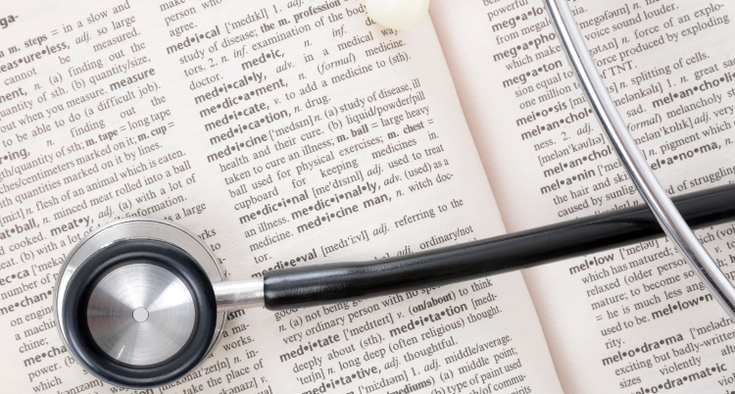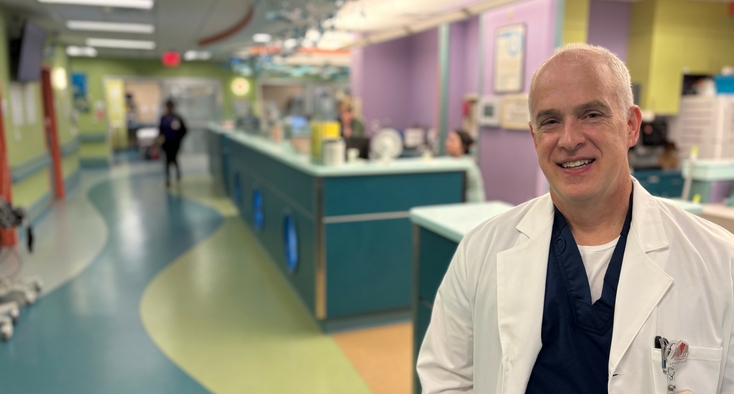At Healthy Headlines, we try to keep the use of medical terminology to minimum for our readers. But there’s no way to write about healthcare guidance and patient journeys without mentioning complex treatment, strategies and surgical procedures. This glossary provides a brief overview of some terms you might encounter.
Ablation: The removal or destruction of tissue, often in the treatment of cancer or heart conditions. It can be done by surgery, hormones, drugs, radiofrequency, heat, etc.
Cardiac ablation – Used to treat irregular heartbeats by passing thin, flexible tubes (catheters) through the blood vessels to the heart and creating tiny scars in the heart. These scars restore a typical heartbeat. The scars can be created with heat, extreme cold, lasers or chemicals.
Ablation therapy for cancer - Procedure to kill cancer cells to treat both primary and metastasized tumors. Ablation therapy is done with either extreme cold or hot temperatures.
Endometrial ablation – Endometrial ablation is a procedure that removes a thin layer of tissue that lines the uterus to help stop or reduce heavy menstrual bleeding. (Heavy menstrual bleeding is described as bleeding that requires changing sanitary pads or tampons every hour.) An endometrial ablation might be needed if the bleeding is so heavy that it affects your daily life and causes anemia, or low blood count. Endometrial ablation can be done through electricity, fluids, balloon therapy, high-energy frequency radio waves, cold and microwaves.
Arthroscopic surgery: An orthopedic procedure that may be recommended to treat joint, tendon or ligament problems. This minimally invasive surgery is done by creating a small incision at the joint. A small tube with a camera and light is inserted in, which allows the surgeon to look into the interior of the joint. Other incisions may be made to insert small instruments throughout the joint to perform the surgery. This type of surgery leaves a much smaller scar and has an easier recovery than open surgery.
Cath lab: Catheterization laboratory (cath lab) is a hospital room, or unit, where minimally invasive tests and procedures are performed to diagnose and treat cardiovascular diseases. It is staffed by a team of different specialists, usually led by a cardiologist.
The procedures in the cath lab can be diagnostic or for treatment, also called interventional. Diagnostic procedures include biopsies and diagnostic cardiac catheterization. Interventional procedures include angiograms, angioplasties, ablations, stenting and thrombectomies.
Angiogram – A heart test that looks at the blood supply of your heart. Dye is injected into an artery in your arm or leg, and an X-ray is taken to look at any narrow coronary arteries that could lead to shortness of breath, chest pain and in more extreme cases, heart attack and heart failure.
Stent – A narrow flexible tube is inserted into your wrist or groin and pushed up to a coronary artery to widen it to improve blood flow to the heart. A tiny wire mesh tube that props open an artery is placed. It helps improve blood flow to the heart and relieve chest pain. The stent stays in the artery permanently.
Angioplasty – A procedure used to open narrowed or blocked arteries. It is done by putting a catheter into the wrist or groin and pushed up into a coronary artery. A small balloon at the end of the catheter is blown up to widen the artery. The surgeon will inflate and deflate the balloon to help flatten out your artery. Most of the time, angioplasties are combined with stents to permanently keep the artery open.
Thrombectomy – Minimally invasive procedure that allows a neurosurgeon to remove clots in the brain (stroke) without opening the skull. A thin wire and catheter (suction tube) are inserted into a blood vessel and travel through them to reach and remove the clot. Traditionally this procedure has been limited to main blood vessels since they are wide enough to accommodate a catheter, but recent advancements have allowed surgeons to remove clots via slender blood vessels.
Fellowship: A fellow is a doctor who has finished medical school and residency and chooses to further study a subspecialty in medicine. Fellowships are optional for physicians to advance their training, and usually last one to three years. They must finish a residency program to qualify (see definition below).
Immunotherapy for cancer: Immunotherapy is a type of cancer treatment that supercharges your immune system to recognize cancer cells and helps your body fight them.
Over the past few years, a new class of immunotherapeutics was developed – checkpoint inhibitors – and has emerged as one of the most promising cancer therapies.
Herniated disc: The vertebrae that form the spine are cushioned by gel-like discs. The discs act as shock absorbers for those spinal bones. A herniated disc occurs when a fragment of the center (nucleus) is pushed out through the outer layer (annulus) and into the spinal canal. When that displacement presses on spinal nerves, it causes pain. Herniated discs are mostly common in the lower back but can also occur in the neck.
Hypertension: Hypertension, also known as high blood pressure, is when the pressure in your blood vessels is too high (140/90 mm Hg or higher). High blood pressure can lead to serious problems such as heart attacks and strokes. It’s often called the “silent killer” because there are no symptoms and can only be diagnosed in a doctor’s office. It’s one the most important reasons to see a doctor or other medical clinician every year.
Minimally invasive procedure: Minimally invasive surgery is done with small incisions and far fewer stitches than traditional “open” surgery. Surgeons use a thin instrument with a light and a camera to help guide the surgery, and tiny surgical instruments are inserted through other openings. The advantages of minimally invasive surgery include less pain, less scarring and damage to tissue. Patients also have a faster recovery, which means they can return to work, family obligations and the life they want to live much quicker. It’s often done via robotic assisted surgery. See below.
Orthopedics: A medical specialty that focuses on the musculoskeletal system – bones, muscles, tendons and ligaments. Orthopedics uses surgical and nonsurgical techniques to treat an array of conditions such as sports injuries, tumors, fractures, degenerative diseases and congenital disorders.
Residency: Following the completion of medical school, physicians will complete their residency which may take between three to seven years. It requires 60 to 80 hours per week of intensive supervised clinical training which provides physicians with hands-on experience.
Residency programs vary in duration depending on the specialty. A doctor is board-eligible to practice medicine in their specialty after completing their residency. During board eligibility, physicians have three to seven years to take a specialty certification exam. Once the examinations are successfully passed, physicians are certified in their specialty.
Robotically assisted surgery: In robotically assisted surgery, the surgeon is at a workstation with controllers and a three-dimensional view of the area of the body being operated on. The word “robot” can be misleading. Unlike manufacturing robots that perform on their own, surgical “robots” are totally controlled by surgeons, who make all the decisions.
Through foot pedals and hand controllers, the surgeon’s movements are translated into robotic arms located over the patient. This complex equipment allows for more precise movements while performing the surgery. Through robotic assisted surgery, most patients experience less pain and scarring, less risk of infection and a quicker recovery time than traditional surgery. When you hear the phrase “minimally invasive surgery,” it’s often being performed with surgical robots.
The use of robotic surgery is especially in orthopedics, and gynecological surgery, but is used across a number of surgical specialties.
Scans: Body scans have become an integral part of medical diagnosis and treatment. Here are some of the more common scans patients may encounter.
CT scan: A computerized tomography (CT) scan uses a series of X-rays taken from different angles to create a more detailed, cross-sectional images of the body. A computer processes these images and creates “slices” of bones, blood vessels, and soft tissues which can help with diagnosis or to create treatment plans. It provides more detail than a regular X-ray.
MRI: magnetic resonance imaging (MRI) is an imaging method that uses powerful magnets and radio waves to produce three dimensional images of soft tissues. The magnetic field excites and detects the movement of protons in living tissues. The MRI sensors detect the energy released which can help assess the different types of tissues detected.
PET: Positron emission tomography (PET) scan is an imaging test that shows your organs and tissues. A radioactive chemical, radiotracer, is injected, and sick cells absorb a large amount of it which can highlight a potential problem. It is typically used to diagnose cancer or assess heart and brain issues.
Ultrasound: It is a diagnostic technique that uses probes called transducers that produce sound waves. During examinations, technicians place a gel on the skin to prevent air pockets that block the sound waves from passing to the body. One of the most common uses for ultrasounds is during pregnancy, but they can also be used to assess the heart, breasts, blood vessels, and other internal organs.
X-ray: You know this one. It’s a form of radiation that generates images – radiographs – of the internal structures of the body. X-rays are used to detect bone fractures, pneumonia, certain tumors or masses, dental problems, and foreign objects in the body.
Mammography: A type of X-ray used to examine breast tissue. During a standard mammogram, images from the top and side view of each breast are taken, and the inner tissues can be seen. Mammograms are typically used for early cancer detection or other abnormalities.
Fluoroscopy: Another type of X-ray that creates a real-time video of the inner movements in the body. Its most common uses are for looking at gastrointestinal movement, guide medical procedures with precise placements, and movement of joints post-surgery.









